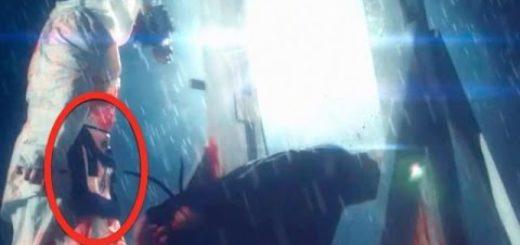
Turner Broadcasting (TNT) on Sunday launched “I Am the Night,” a television miniseries “inspired by true events” that presents Hollywood gynecologist Dr. George Hill Hodel as the Black Dahlia killer.
The story is reportedly draws upon two published works: “The Black Dahlia Avenger: The True Story” and “One Day She’ll Darken.”
“The Black Dahlia Avenger” (2003) is one of several books written by Dr. Hodel’s son, Steve Hodel, a retired Los Angeles Police Department detective. Det. Hodel provides unprecedented levels of research and evidence that his father was responsible not only for the murder of Black Dahlia (Elizabeth Short) but also for countless other unsolved slayings (see Russ’ post below).
“One Day She’ll Darken” (2008) is a book based on the memoirs of Faun Hodel, the granddaughter of Dr. Hodel. I’m not familiar with the work, so I’ll provide a Vanity Fair excerpt:
After her father, Dr. George Hodel, a prominent Hollywood physician was acquitted in a sensational incest trial, 16-year-old Tamar gave birth to a blue-eyed, white skinned baby girl. … [Her] mother quickly arranged to have the baby permanently given away to Jimmie Lee, a black maid in a Nevada casino. Overwhelmed by the problems of raising a white-skinned baby in her black community, Jimmie spent the next 26 struggling to secretly raise Fauna. … Fauna sets out to discover the truth [about her parents], only to uncover her family’s notorious secret: her extraordinary grandfather and the murder of the Black Dahlia.
The series’ first episode tonight introduced us to the two main characters: Faun and the (fictional?) character of a downtrodden investigative reporter focused on Dr. Hodel’s debauchery. There was no blatant debauchery in Episode 1; however, the trailer definitely has shades of “Eyes Wide Shut” themes.
In November, Russ wrote the following eye-opening article about Dr. Hodel and the Dahlia Murder. This post was just one of several that focused on hidden organized crime networks behind so-called “lone wolf” killers. Others included the Smiley Face Killers, Gacy, Berkowitz, Dutroux and the Franklin Scandal.
How much will TNT’s miniseries reveal? How deep are they willing go? I guess we’ll have to wait and see. Given that the series’ tagline is “Some Stories Don’t Want to be Told,” I’m not super optimistic. Episode 2 is scheduled to air on Feb. 4.
By Russ Winter
In 1949, Los Angeles Police Department (LAPD) detectives placed Dr. George Hodel, Jr. (1907-1999) on the top of the list of suspects in the gruesome dismemberment of Hollywood actress of Elizabeth Short, which is more widely known as the Black Dahlia murder. Dr. Hodel was questioned but never charged.

In a strange twist of irony, Dr. Hodel’s son, Steve Hodel, himself became a LAPD homicide detective. After his 24-year tenure with the department and starting in 1999, he delved deeply into the Dahlia case, which in turn led to other unsolved murders, and came to the conclusion that his father was most likely responsible for Short’s death but also numerous others spanning decades.
Dr. Hodel died in 1999 and his son retired from the LAPD in 1983. In 2005 Steve published his revelations that his father was likely responsible for the Black Dahlia murder as well as the Lipstick Murders 1945 and ’46; the Jigsaw Murder in Manila, Philippines, in the 1960s; and quite possibly the Zodiac murders in California’s Bay Area in the late 1960s and early ’70s.
A simple search of YouTube will produce results for several one-hour interviews detailing Steve Hodel’s journey down this rabbit hole. I have to commend him for his courage and determination in revealing inconvenient truths. Humanity needs many more people like him.
Dr. Hodel was raised in Pasadena, California. His parents, were of Russian-Jewish ancestry. Their only son, George, was well-educated and scored 186 on an early I.Q. test. He was a musical prodigy, playing solo piano concerts at Los Angeles’ Shrine Auditorium. After a stint as a crime reporter, he became a physician and in the 1940s was Los Angeles County Health Director with a focus on venereal diseases. He was also involved at that time in illegal abortions. Despite his trips to the evil dark side, he was highly functioning and died wealthy at age 91.
 Dr. Hodel mingled among affluent Los Angeles society. His circle of friends included Russian-Jewish photographer Man Ray (aka Emmanuel Radnitzky) (1890-1976), film director John Huston and artist/sculptor Fred Sexton. His son suspects Sexton may have been an accomplice. Dr. Hodel, John Huston and Fred Sexton were close friends from their teen years through adulthood. Sexton lived out the final decades of his life in Mexico after molesting his 11-year-old stepdaughter at their Palos Verdes, Calif., residence in 1968.
Dr. Hodel mingled among affluent Los Angeles society. His circle of friends included Russian-Jewish photographer Man Ray (aka Emmanuel Radnitzky) (1890-1976), film director John Huston and artist/sculptor Fred Sexton. His son suspects Sexton may have been an accomplice. Dr. Hodel, John Huston and Fred Sexton were close friends from their teen years through adulthood. Sexton lived out the final decades of his life in Mexico after molesting his 11-year-old stepdaughter at their Palos Verdes, Calif., residence in 1968.
Dr. George Hodel came under police scrutiny in October 1949, when his 14-year-old daughter, Tamar, accused him of raping and molesting her. Despite three witnesses testifying that they had seen Hodel having sex with Tamar, he was acquitted in December 1949. It was later revealed that there was a $15,000 payoff to the Los Angeles district attorney to make this case go away.
 It was the murder of Elizabeth Short — who was called the “Black Dahlia” — that received the most attention. She was brutally tortured and mutilated, cut cleanly in half, drained of all her blood and finally and grotesquely displayed on a vacant Los Angeles lot on Jan. 15, 1947. Det. Steve Hodel found evidence that Short was part of Dr. Hodel’s libertine social sexual-circle and may have stumbled across the more lethal side.
It was the murder of Elizabeth Short — who was called the “Black Dahlia” — that received the most attention. She was brutally tortured and mutilated, cut cleanly in half, drained of all her blood and finally and grotesquely displayed on a vacant Los Angeles lot on Jan. 15, 1947. Det. Steve Hodel found evidence that Short was part of Dr. Hodel’s libertine social sexual-circle and may have stumbled across the more lethal side.
In another L.A. murder case in which Dr. George Hodel was a suspect, a police informant known as “Martin” wrote a letter claiming that both he and “GH” personally knew victim Louise Springer and that he believed “GH” killed her in June 1949. LAPD at that time was actively investigating the Springer and Black Dahlia murders and had publicly identified them as “probably connected.”
Mrs. Springer was sadistically murdered on June 13, 1949, just two blocks from where the body of Elizabeth Short was found in 1947. Included in the letter was the fact that the LAPD, after being informed that “GH” knew victim Springer, took “GH” into custody “and grilled about the Springer murder.” The Martin Letter made it clear that “GH” was known and protected by law enforcement officers, and that they befriended him and “let him go.”
Steve, thinking he was a known entity at LAPD, assuming closing these cold cases would be a formality. However, he soon discovered that records related to his father were strangely missing. He did, however, arrange to examine files at the Los Angeles District Attorney’s Office. The “George Hodel-Black Dahlia File” was discovered in a vault.
The file revealed that in 1950, Hodel was the prime suspect of the Dahlia murder. Transcript notes show Hodel’s private Hollywood residence was electronically bugged by an 18-man D.A./LAPD task force from Feb. 18 to March 27, 1950. The transcripts of conversations revealed constant Hodel drama and references to performing illegal abortions, giving payoffs to law enforcement officials and to his possible involvement in the deaths of his secretary and Elizabeth Short. At one point, what sounds like a beating and screams occurred.
The D.A. tapes recorded him saying:
“Supposin’ I did kill the Black Dahlia. They can’t prove it now. They can’t talk to my secretary anymore because she’s dead. They thought there was something fishy. Anyway, now they may have figured it out. Killed her. Maybe I did kill my secretary.”
The secretary referred to was Ruth Spaulding, who police had previously suspected of being murdered by Hodel in 1945. He was present when Spaulding overdosed and had burnt some of her papers before police were called. The case was dropped owing to lack of evidence, but documents were later found that indicated Spaulding was about to publicly accuse Hodel of intentionally misdiagnosing patients and billing them for laboratory tests, medical treatment and prescriptions not needed.
Steve believes Elizabeth Short may have been one of his father’s patients.
In October 1949, George Hodel’s name was mentioned in a formal written report to the grand jury as one of five prime suspects, but none of the named suspects were submitted to the 1949 Grand Jury for consideration for indictment as the investigation was “ongoing.”
By April 1950, Lt. Jemison had gathered enough evidence to charge Dr. Hodel and was about to arrest him for the Short murder when Dr. Hodel fled the United States.
In 1990, Dr. Hodel and his fourth wife, June, returned to the U.S. from Manila. In Manila, there was a bisection murder case similar to that of the Black Dahlia. It was called the Jigsaw Murder, and likely the handiwork of Dr. Hodel.
Steve sees evidence that Dr. Hodel was responsible for at least one of the 1960s Zodiac killings. There may have been copycat killers in the Zodiac cases. Or, conversely, Hodel himself may have been a copycat killer. In some composite drawings, he’s a dead ringer.

Modus operandi and crime signatures of Dr. George Hodel:
Sidekicks and Flying Monkeys
As we demonstrated in our posts on the Dutroux Case, the Franklin Scandal, John Wayne Gacy and Jimmy Savile, these types of high functioning serial killers tend to attract minions and fellow travelers. Some flying monkeys are more active, while others are more the audience.
Also heard on the Dahlia police tapes was reference to another possible sidekick. From Steve Hodel’s blog:
“Baron” Harringa just two-years after his assault and/or murder (accomplice to my father) of the unidentified woman in the basement of our Hollywood home. As we recall her beating and screams by the two men were tape recorded during the LAPD/DA stakeout, with detectives just five minutes away, but officers made no response or rescue and the victim was never identified.

The relationship between Dr. Hodel and Man Ray (aka Emmanuel Radnitzky) is covered in the Mark Nelson and Sarah Hudson Bayliss book “Exquisite Corpse: Surrealism and the Black Dahlia Murder.”
The numerous social interactions between the two men is documented in detail here.
Some of the Man Ray photos of Hodel and his third wife, Dorothy, were offered at a Sotheby’s auction.
Here is a Man Ray photo of Hodel, an unknown photo of Elizabeth Short circa 1946 and a Man Ray 1970 lithograph of, we would say, Elizabeth Short.

The following hash pattern was carved by Hodel into Short’s torso and the same pattern appears in Man Ray’s 1943 piece “L’equivoque.”

More background on Dr. Hodel and Man Ray. Dr. Hodel was in to hypnosis and failed to distinguish between his dream state and reality.
Dr. Hodel would hold regular parties in his Lloyd Wright (son of Frank)-designed Mayan-style Hollywood estate. In attendance was Henry Miller and others from Hollyweird.
During this period, writers like Henry Miller and Lawrence Durrell were gathering around the Villa Seurat with assorted Dadaists and existentialists to discuss the philosophical “virtues” of incest, rape, torture, murder and sexual domination. These misfits of S&M depravity were complemented by the sub-artisan shock tactics of the surrealist art movement, which delighted in presenting to the world the image of a young girl’s eyeball being razored or torso gutted, among other deprivations.
Chief among this new generation of free-willed non-conformists was the photographer Man Ray (Emmanuel Radnitzky), whose famous work “Minotaur” is to play an important part in this story.
Nelson and Bayliss pointed out the deliberate inclusion of surrealist motifs by the killer on the corpse and in the corpse’s display. The contrived configuration in which Elizabeth Short’s severed upper torso was found shares remarkable similarities to the composition of the Man Ray work called “Minotaur,” a photo replete with popular surrealist symbolism and archetypes.

Here are numerous excerpts from surrealist art and influential precursors, with heavy emphasis on sadistic, criminal behavior. Beside Man Ray, we see the world of Salvador Dali. Most of this predates the Black Dahlia murder. We aren’t going to paste the photos of poor split Elizabeth Short, but the crime pictures here can be compared with Man Ray’s and his ilk’s works. You can see that Short was definitely posed for a surreal effect. It explains why Elizabeth Short became an “exquisite corpse” and not just another sex-crime statistic.
While his peers merely painted and photographed facsimiles of the destroyed female torso, Dr. Hodel actually did it! Pathetic as it sounds, this is considered among certain types as proof of one’s elite status, i.e. true freedom! Yes, this is the same ultimate-freedom goal in life, as mentioned by Jimmy Saville in his infamous interview with Dr. Antony Clare.
What we are witnessing is the fundamental “I am God” Luciferian-Frankist philosophy, which we covered in the cornerstone article “Clues Hidden in Plain Sight About Jimmy Savile’s True Nature.”

Troy D. McLachlan in “The Minotaur & The Black Dahlia Avenger” also offers insights about Luciferian doctrines we have discussed:
Between the 1920s and the late 1940s the violent libertine doctrines of an 18th century French aristocrat called the Marquise de Sade had become popular fare amongst so-called and self-styled ‘sexual sophisticates’. That particular era also embraced another notable contribution to a growing list of literature dealing with abusive sexual practises incorporating ritualistic undertones, the very strange Venus in Furs by Leopold von Sacher-Masoch.
For genuine aficionados’ of de Sade, Masoch and Reage (like Hodel and friends) the thrill of BDSM as a living philosophy could only be surpassed by its actual application to unwilling victims. Murder for sexual pleasure thus becomes the ultimate combination of artistic freedom and complete dominance over another human being.
The studied posing of Elizabeth Short’s bisected torso becomes a symbolic statement to be understood by those with eyes to see. In this we can see how her carefully displayed body may have indicated a need on the part of the killer to incorporate recognisable ritualistic archetypes and symbols into the corpse of Elizabeth Short as a statement of arrival into rarefied circles.
The true link between your common garden variety occultist and adherents to de Sade’s frightening brand of hedonism, those such as George Hodel, is found in a shared definition of the concept of freedom. This is loosely defined as the will of the individual to prove they can ascend to true freedom via quasi acts of ritual or outright acts of savagery. The driving force behind such horrific acts is revealed to be the pursuit of ‘power’, followed by the recognition of that power by others
The French aristocrat’s literary efforts continue to influence would-be misanthropes and it is noteworthy that Steve Hodel points to the Marquis as a possible ‘kindred spirit’ to his father. What we do know is that the Marquis’ writings formed a part of George Hodel’s personal library with a good proportion of de Sade’s narratives focused on victims being forced to eat feces, amongst other more unsavoury acts. It must be remembered that Elizabeth Short’s autopsy revealed she was forced to eat feces.
The ligature marks around the throat show signs of strangulation; the sinister ‘joker smile’ that had been carved into her cheeks from the corners of her mouth; the minute slits to her upper lip; the blunt trauma to the head that actually killed her; and the multiple cigarette burns to her back (proven by Steve Hodel to exist- see section 27.4 in this PDF). There are deep mutilations to her torso; the right breast, her left side and thigh, her pelvic region and genitalia; all sinister markings in the extreme with her body finally bisected at the waist.
The audience of peers can be identified as those belonging to a class of people calling themselves the ‘aristocracy of purpose’, a term used by renowned Bilderberger observer Daniel Estulin to describe those elitists who aspire to dictate the affairs of mankind from behind the scenes. In the case of George Hodel, his prospective peers would seem to have been those elitist artists active in the spheres of art and celebrity.
I have seen a few long-winded but weak articles by shills online claiming that Det. Steve Hodel alone holds to the theory of Dr. Hodel as the killer of Elizabeth Short. This is not even remotely true. Here is a rundown of various police officers, past and present, who’ve been on the case.
Steve Hodel in an interview with Ed Opperman theorized that Dr. Hodel had the goods on the LAPD and had them compromised. He would have had intel on most of the venereal disease cases in L.A. But in this appearance, he is flustered about the failure of the police to wrap this case up.
Although he speaks about LAPD’s corruption and expediency, perhaps he doesn’t fully appreciate to what degree and to what extent Dr. Hodel and his circle had the police compromised, controlled and over a barrel. Nobody seems to really fully understand that, even hardened criminal investigators.
As regular readers know, we have shown ad nauseum on our pages that highly functioning criminals operate as groups (not lone wolves) of power brokers.

 It was the murder of Elizabeth Short — who was called the “Black Dahlia” — that received the most attention. She was brutally tortured and mutilated, cut cleanly in half, drained of all her blood and finally and
It was the murder of Elizabeth Short — who was called the “Black Dahlia” — that received the most attention. She was brutally tortured and mutilated, cut cleanly in half, drained of all her blood and finally and 











